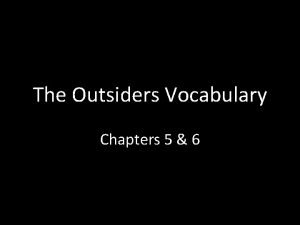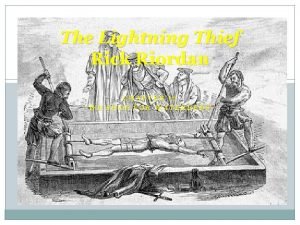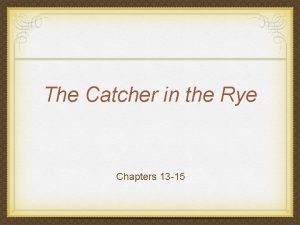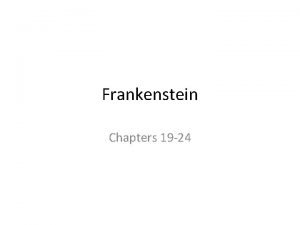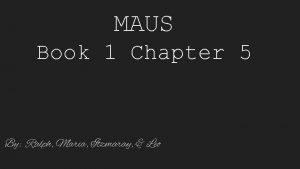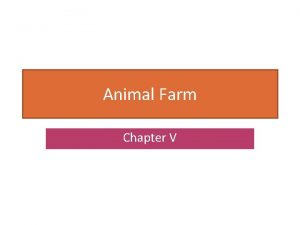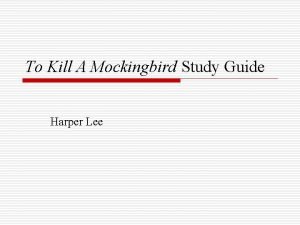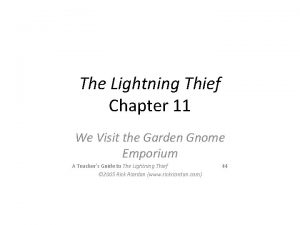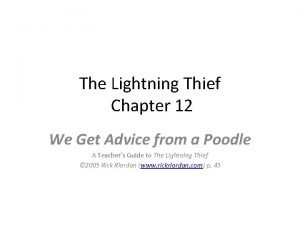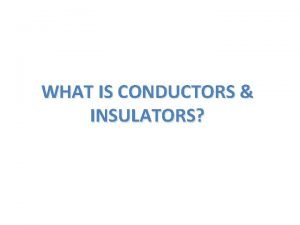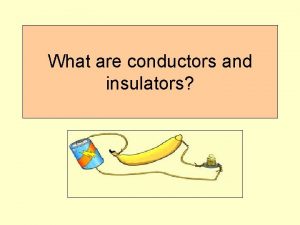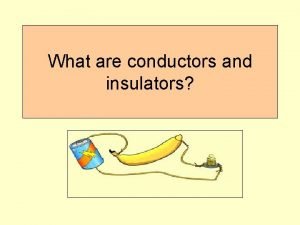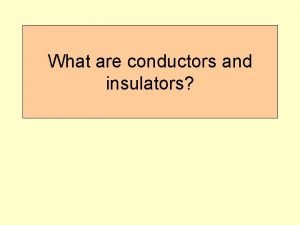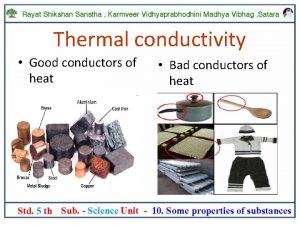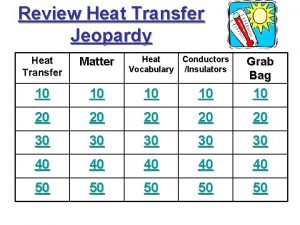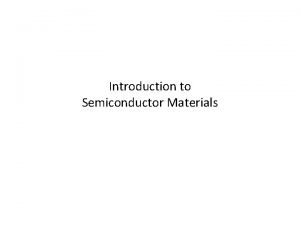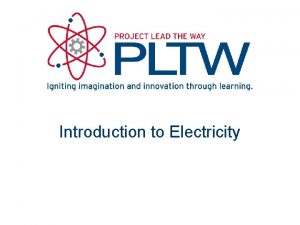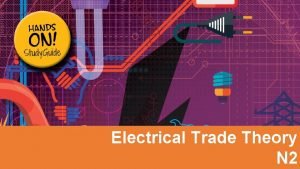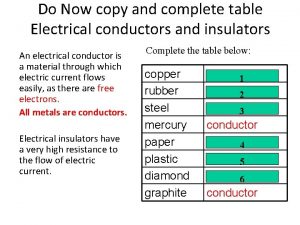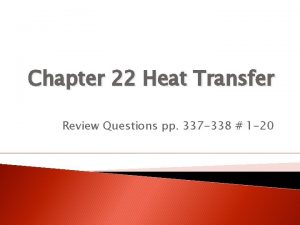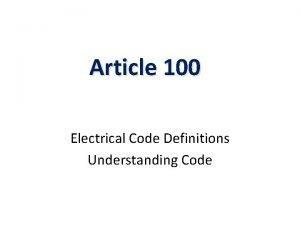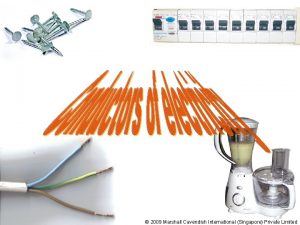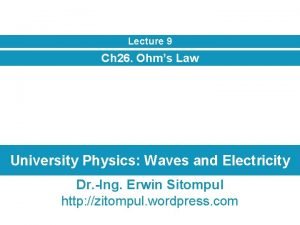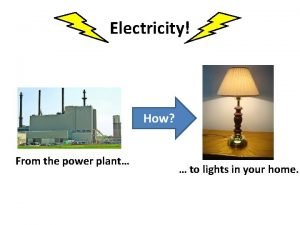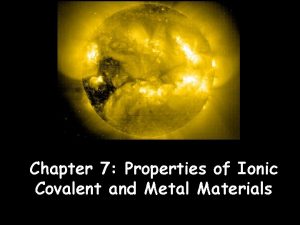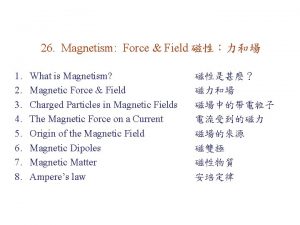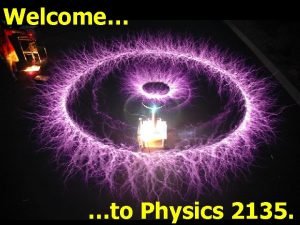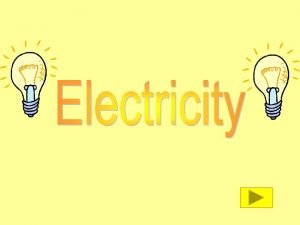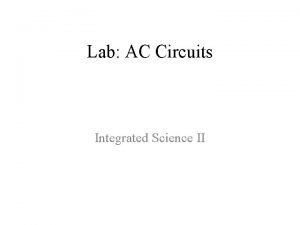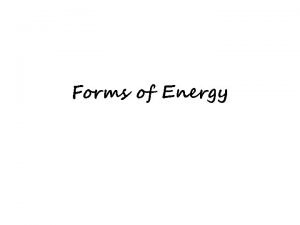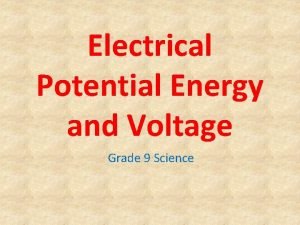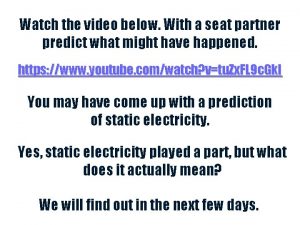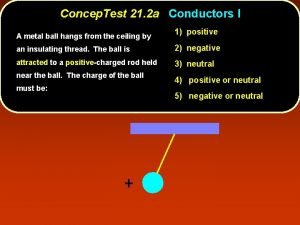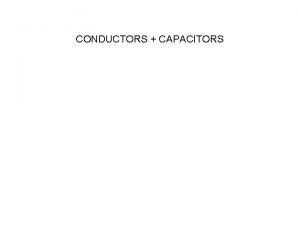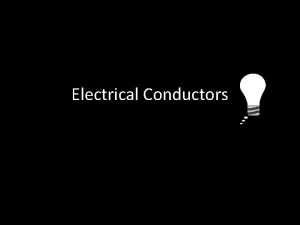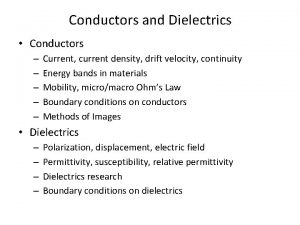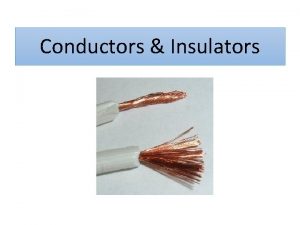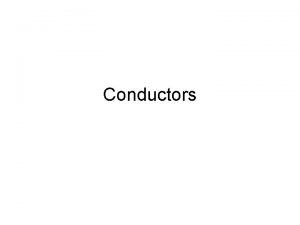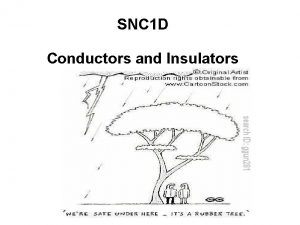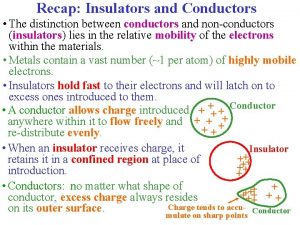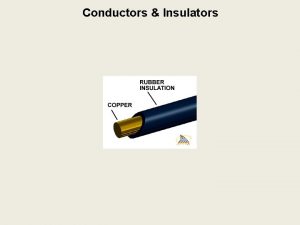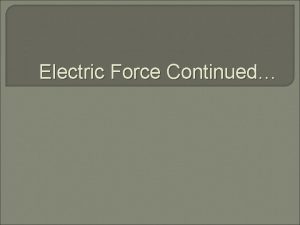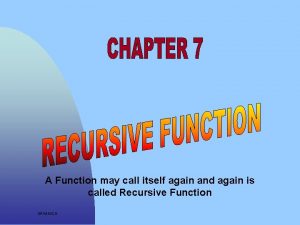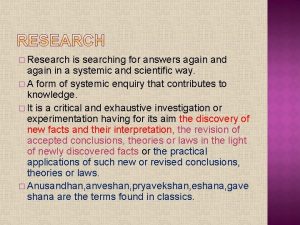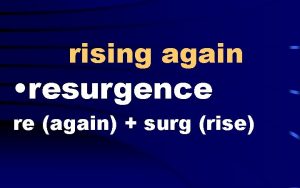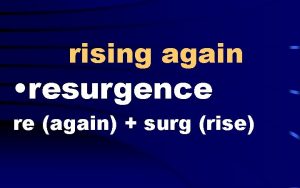Chapter 15 Conductors again What happens to a























![So, what are the units of V? DV = DPE/q So. . . [DV]=[DPE]/[q] So, what are the units of V? DV = DPE/q So. . . [DV]=[DPE]/[q]](https://slidetodoc.com/presentation_image_h/c6497fb77c37fae61bd288c0016fcae9/image-24.jpg)




























![C = eo. A/d [C] = [eo] [A] / [d] [C] = C 2 C = eo. A/d [C] = [eo] [A] / [d] [C] = C 2](https://slidetodoc.com/presentation_image_h/c6497fb77c37fae61bd288c0016fcae9/image-53.jpg)






















- Slides: 75

Chapter 15 Conductors (again)


What happens to a conductor when you place it in an electric field and allow the charges on it to attain equilibrium? E conductor (Remember, charges are free to move around on the surface of conductors. )

1) no electric field exists inside the conductor. What if it did? Then an electrical force would be exerted on the charges present in the conductor. In a good conductor, charges are free to move around, and will when a force is exerted on them. If charges are moving around, we are not in equilibrium.

2) Excess charges on an isolated conductor are found entirely on its surface. The 1/r 2 nature of the electrostatic repulsive force is responsible for this one. The excess charges are trying to get as far away from one another as possible. It turns out, therefore, they all end up on the surface of the conductor.

3) The electric field just outside of a conductor must be perpendicular to the surface of the conductor. Again, what if this were not the case? Then a component of the electric field would exist along the conductor’s surface. This would yield an electrical force along the surface. As a good conductor, charges would move around in the presence of the force. . .

4) On an irregularly shaped conductor, charges build up near the points (regions with smallest curvature). --- - E Charges build up here: not as much room for them to move apart! - -

In both cases, you are advised to THINK about the direction!


What is ? To determine the direction of the , simply join point A to point B. The sign of their charges does not matter! B A Just connect the dots! points from the charge creating the field toward the charge of interest regardless of their signs!

The notion of is just that of a coordinate system centered on the object of interest. We’re probably most familiar with the Cartesian coordinate system z q r (x, y, z) or (r, q, f) y f x

z y x points radially outward from the origin of the coordinate system.

When you use (and only when you use this formulation) the signs of the charges become mathematically meaningful in the formulae you apply to the problems! If you use the book’s formulation, you must take the absolute values of the signs and THINK about the direction of the vector quantities you are calculating!!! Use whatever works for you!

Electrical Energy and Capacitance Recall that in the presence of the gravitational field, we defined potential energy and work done. This work could be done by any Newtonian force. We’ll now define similar quantities for electrical forces. We also examine the capacity of systems that hold charge.


A force is conservative if the total work it does on a particle is zero when the particle moves exactly once around any closed path.

The work done on a particle by a conservative force is independent of the path a particle takes to move from one point to another.

Work = Force through a distance W = F|| d For the electrostatic force. . . W=q. Ed Scalar quantity! No directions! Electrical work is “Quite Easily Done!” NOTE: d is the distance parallel to the Electric field only!!! Project the electric field vector onto the displacement vector.

r q E d W = q Ed NOT q E r !!!

r q d E W = q Ed As long as the electric field is uniform, this is the answer!

Recall: Potential Energy and Work are Related. . . DPE = -W = -q E d Only valid in a uniform electric field! Notice that work and potential energy are scalar quantities, NOT vectors! (i. e. they have no directional components) Example: speed is a scalar velocity is a vector


A B A useful quantity in examining problems with charges is the electrical potential difference. This quantity is NOT the potential energy. Rather, the electrical potential difference is given by DV = Vb-Va = DPE/q DV is the change in potential energy per unit charge as the charge moves from point A to point B.
![So what are the units of V DV DPEq So DVDPEq So, what are the units of V? DV = DPE/q So. . . [DV]=[DPE]/[q]](https://slidetodoc.com/presentation_image_h/c6497fb77c37fae61bd288c0016fcae9/image-24.jpg)
So, what are the units of V? DV = DPE/q So. . . [DV]=[DPE]/[q] [DV] = J/C = 1 Volt 1 Joule of energy is required to move 1 Coulomb of charge through a potential difference of +1 Volt.

DV = Vb - Va = DPE/q DPE = -W = -q E d REMEMBER, d is measured in direction of E only!!! NOTE: This ONLY works for a uniform electric field!! DV = - q E d/q = -E d [DV] = [E] [d] 1 Volt = (N/C) m = J/C !

DV = - E d, Wilbur! It’s EASY!

Does DV = -Ed in the field around a point charge? +

What happens to the potential energy of a charge as it moves in the direction of the electric force? +q d The electric field DOES work on + q, therefore, the potential energy must…. . . E

Remember, the change in potential energy is minus the work done by the field force. What happens to the potential of a charge as it moves in the direction of the electric force? +q E d Va Vb

+q E d Va Vb Vb - Va = - E d It decreases in the direction of the electric field, REGARDLESS OF THE SIGN OF THE CHARGE!

So, how’s this work for point charges? First, assume that the potential in the field of a point charge is ZERO at infinity (we did something similar for gravity, right? ) Use Calculus…. VOILA! scalar!

V>0 around positive charges V<0 around negative charges The superposition principle applies to potentials! Vtot = V 1 + V 2 + V 3 +. . .


How much work do we do in bringing a point charge (q 2) from infinity to a distance r from point charge q 1? q 1 r q 2

PE > 0 for LIKE charges PE < 0 for opposite charges You could probably have guessed that PEtot = PE 1 + PE 2 + PE 3 +. . .

+q A Fe d B E What happens to the potential energy of a positive charge (+q) as it moves in the direction of the electric field? DPE = - q E d = - (+q) E d = - q E d

-q A Fe d B E What happens to the potential energy of a negative charge (-q) as it moves in the direction of the electric field? DPE = - q E d = - (-q) E d = + q E d

+q A Fe B d E What happens to the potential of a positive charge (+q) as it moves in the direction of the electric field? DV = - E d

-q A Fe B d E What happens to the potential of a negative charge (-q) as it moves in the direction of the electric field? DV = - E d

The electrical potential ALWAYS decreases in the direction of the electric field! It does not depend upon the sign of the charge. The electrical potential energy depends upon the sign of the charge. It decreases in the direction of the electrical force.

What is the potential at point p? p 1 m q 1 Vtot = V 1 + V 2 2 m q 1 = +2 m. C q 2 = -5 m. C q 2

p What is the potential at point p? 1 m q 1 2 m q 1 = +2 m. C q 2 = -5 m. C q 2 Vtot = V 1 + V 2 V 1 = 18, 000 V V 2 = -20, 125 V Vtot = -2, 125 V

p 1 m q 1 2 m q 1 = +2 m. C q 2 = -5 m. C q 2 How much work is required to bring a 5 m. C charge from infinity to point p? W= (5 X 10 -6 C) (-2, 125 V) = -1. 1 X 10 -2 J

An equipotential surface is a set of points in an electric field which are all at the same electrical potential. One example is the locus of points equidistant from an isolated point charge. Electric field lines Equipotential surfaces

Notice that the equipotential surfaces are perpendicular to the electric field lines everywhere! Remember that work is only done when a charge moves parallel to the electric field lines. So no work is done by the electric field as a charge moves along an equipotential surface. This is just like GRAVITY, right?

The potential difference between any two points on an equipotential surface (Vb - Va ) must be. . .

When in electrostatic equilibrium (i. e. , no charges are moving around), all points on and inside of a conductor are at the same electrical potential!

Remember that the electric field is everywhere perpendicular to the surface of a conductor, and is zero inside of a conductor. So, from the surface of a conductor throughout its interior the electric field is 0 when the conductor is in electrostatic equilibrium. DV = - E d = 0

+Q d -Q A common type of capacitor consists of a pair of parallel conducting plates, one charged positively, one charged negatively.

+Q d E -Q An electric field exists between the plates of a capacitor. Therefore….

Capacitance is the ability to store charge. A d C = eo. A/d On what could capacitance possibly depend? Think geometrically….

C = eo. A/d eo = permittivity of free space = 8. 85 X 10 -12 C 2/Nm 2 This quantity is related to another constant with which we are already familiar in electrostatics: k = 1 / 4 p eo
![C eo Ad C eo A d C C 2 C = eo. A/d [C] = [eo] [A] / [d] [C] = C 2](https://slidetodoc.com/presentation_image_h/c6497fb77c37fae61bd288c0016fcae9/image-53.jpg)
C = eo. A/d [C] = [eo] [A] / [d] [C] = C 2 m 2 N m 2 m = C 2 J = 1 Farad = C / V C V

What happens when you connect a capacitor to a battery? _ + + _ V C Circuit Diagram

+ _ V C +Q -Q The battery converts internal chemical energy to electrical energy, pulling electrons off the top plate of the capacitor and pushing them onto the lower plate of the capacitor until the capacity of the capacitor is reached. At that point, each plate of the capacitor holds a charge Q. The battery maintains a potential difference across its terminals (and hence, the capacitor) of V.

C=Q/V Notice this has the same units as the quantity we derived earlier! 1 Farad = C / V

C=Q/V This definition of capacitance is particularly useful since it does not require us to have any knowledge about the geometry of the capacitor. Using this definition, capacitance can be determined solely from the behavior of the electrical circuit.

+ _ V C 1 C 2 So, what happens after the battery is connected to this circuit? Charge of Q 1 = C 1 V accumulates on capacitor C 1. Charge of Q 2 = C 2 V accumulates on capacitor C 2.

+ V _ C 1 C 2 We can construct an equivalent circuit with a single capacitor. . . + _ V Ceq +(Q 1+Q 2) - (Q 1+Q 2) Ceq = (Q 1 + Q 2) / V = C 1 + C 2 Capacitors in parallel ADD.

+ _ V +Q -Q C 1 C 2 +Q -Q So, what happens after the battery is connected to this circuit? V 1 + V 2 = V Q 1 = Q 2 due to conservation of charge!

+ +Q -Q C 1, V 1 V _ C 2, V 2 +Q -Q We can construct an equivalent circuit with a single capacitor. . . + _ V Ceq +Q -Q Ceq = Q / V V 1 = Q / C 1 V 2 = Q / C 2 V = V 1 + V 2

+ _ V +Q Ceq -Q Ceq = Q / V Ceq = Q Q / C 1 + Q / C 2 1 Ceq = 1 C 1 + 1 C 2 Capacitors in series ADD INVERSELY.

DV = 1 Volt + e- _ An electron is accelerated across a potential difference of 1 Volt. It gains kinetic energy as it moves across the potential, losing potential energy. This particular amount of energy is known as. . .

The amount of energy 1 electron gains when accelerated through a potential difference of 1 Volt. 1 e. V = (1. 6 X 10 -19 C) (1 V) = 1. 6 X 10 -19 J

Can you name some examples of devices that use the energy stored in capacitors? Capacitors store charge. It takes work to put charges on capacitors. That work becomes the potential energy of the capacitor. So capacitors store energy. We take advantage of this all the time!

How much work does it take to charge a capacitor? W=q. V Start with uncharged plates. V = 0 +Dq So it requires almost no work to bring up the first bits of charge, Dq. -Dq

Now that our capacitor has a charge Dq, what is the potential difference between the plates? +Dq -Dq V=Q/C V As we bring up more and more charge, V increases with Q at the rate 1/C, so we can plot V as a function of Q: Slope = 1 / C Dq Q

The total amount of work to bring charge Q onto an initially uncharged capacitor, therefore, is simply the area under the curve: V V=Q/C Q Q=CV

U = INTERNAL ENERGY of the capacitor. This is where the energy comes from to power many of our cordless, rechargeable devices…When it’s gone, we have to plug the devices into the wall socket to recharge the capacitors!

Just so you know. . . Insulating materials between capacitor plates are known as dielectrics. In the circuits we have dealt with, that material is air. It could be other insulators (glass, rubber, etc. ). Dielectric materials are characterized by a dielectric constant k such that when placed between the plates of a capacitor, the capacitance becomes C = k Co Co is the vacuum (air) capacitance.

Dielectrics, therefore, increase the charge a capacitor can hold at a given voltage, since. . . Q = C V = k Co V k Co


We’ve already used this concept, even though we haven’t formally introduced it. What do you think of when you hear the word “current? ”

Electrical Current is simply the flow of electrical charges. charge carriers moving charges. can be + or - A The current is the number of charges flowing through a surface A per unit time.

By convention, we say that the direction of the current is the direction in which the positive charge carriers move. Note: for most materials we examine, it’s really the negative charge carriers that move. Nevertheless, we say that electrons move in a direction opposite to the electrical current. Leftover from Ben Franklin!
 Again and again signpost examples in books
Again and again signpost examples in books Example of alliteration in song lyrics
Example of alliteration in song lyrics Raise and rise again until lambs become lions
Raise and rise again until lambs become lions What is a signpost in reading
What is a signpost in reading What is chapter 27 about in to kill a mockingbird
What is chapter 27 about in to kill a mockingbird Tkam chapter 22 summary
Tkam chapter 22 summary Chapter 12-15 to kill a mockingbird summary
Chapter 12-15 to kill a mockingbird summary Where is enfield prison farm said to be in chapter 23
Where is enfield prison farm said to be in chapter 23 Their eyes are watching god chapter 13 summary
Their eyes are watching god chapter 13 summary The outsiders book chapter 5
The outsiders book chapter 5 Summary of chapter 17 percy jackson the lightning thief
Summary of chapter 17 percy jackson the lightning thief Epiphany in the great gatsby
Epiphany in the great gatsby The great gatsby chapters 3 and 4
The great gatsby chapters 3 and 4 What happens between holden and sunny?
What happens between holden and sunny? Main events in chapter 8 lord of the flies
Main events in chapter 8 lord of the flies Lord of the flies chapter 4 summery
Lord of the flies chapter 4 summery Chapter 11 lord of flies summary
Chapter 11 lord of flies summary Frankenstein chapter 24
Frankenstein chapter 24 Summary of chapter 10 to kill a mockingbird
Summary of chapter 10 to kill a mockingbird Great gatsby chapter 7 summary
Great gatsby chapter 7 summary Chapter 17 to kill a mockingbird summary
Chapter 17 to kill a mockingbird summary Summary chapter 1 to kill a mockingbird
Summary chapter 1 to kill a mockingbird To kill a mockingbird summary chapter 2
To kill a mockingbird summary chapter 2 To kill a mockingbird chapter 10
To kill a mockingbird chapter 10 Things fall apart chapter 17-19 summary
Things fall apart chapter 17-19 summary Scarlett letter chapter 15
Scarlett letter chapter 15 Chapter 9 outsiders questions
Chapter 9 outsiders questions Ruefully definition in the outsiders
Ruefully definition in the outsiders What thought angers katniss (p. 167)?
What thought angers katniss (p. 167)? Mala spiegelman
Mala spiegelman What happens in chapter 26 of catcher in the rye
What happens in chapter 26 of catcher in the rye Bud not buddy summary chapter 11
Bud not buddy summary chapter 11 What happened to mollie in chapter 5 of animal farm
What happened to mollie in chapter 5 of animal farm Questions about animal farm
Questions about animal farm To kill a mockingbird study guide
To kill a mockingbird study guide What does aunty em look like when she opens the door?
What does aunty em look like when she opens the door? Hatchet chapter 5
Hatchet chapter 5 Hatchet chapter 18
Hatchet chapter 18 Percy jackson chapter 12
Percy jackson chapter 12 Chapter 10 the kite runner
Chapter 10 the kite runner Kite runner chapter 22
Kite runner chapter 22 What is conductor and insulator
What is conductor and insulator Picture of conductors and insulators
Picture of conductors and insulators What are conductors
What are conductors Is scissors a conductor or insulator
Is scissors a conductor or insulator Conductor in science
Conductor in science Jeopardy conductor
Jeopardy conductor Atomic structure of a conductor
Atomic structure of a conductor Voltage in parallel circuit
Voltage in parallel circuit How to measure heat energy
How to measure heat energy Conductors and cables n2
Conductors and cables n2 26109-17
26109-17 Table of conductors and insulators
Table of conductors and insulators Chapter 22 heat transfer exercises answers
Chapter 22 heat transfer exercises answers Ready accessibility to wiring in luminaires is
Ready accessibility to wiring in luminaires is Insulator examples
Insulator examples Si unit for ohm
Si unit for ohm A _____________ is a round raceway that houses conductors.
A _____________ is a round raceway that houses conductors. Insulators and conductors
Insulators and conductors Why are molecular compounds poor conductors
Why are molecular compounds poor conductors Force between parallel conductors
Force between parallel conductors Studyjams heat
Studyjams heat Are dielectrics conductors
Are dielectrics conductors Physics 2135
Physics 2135 Example of conductors
Example of conductors Investigating conductors lab report
Investigating conductors lab report Contrast conductors and insulators.
Contrast conductors and insulators. Non conductors of electricity
Non conductors of electricity Electrical conductors
Electrical conductors A metal ball hangs from the ceiling by an insulating thread
A metal ball hangs from the ceiling by an insulating thread Wonderful words of life song
Wonderful words of life song Chapter 26 hunger games
Chapter 26 hunger games Ever since the big blowout she and i haven't gotten along
Ever since the big blowout she and i haven't gotten along Sentences that start with unless
Sentences that start with unless The weather has been nice but it may snow again any day
The weather has been nice but it may snow again any day Rise and rise until lambs become lions
Rise and rise until lambs become lions









